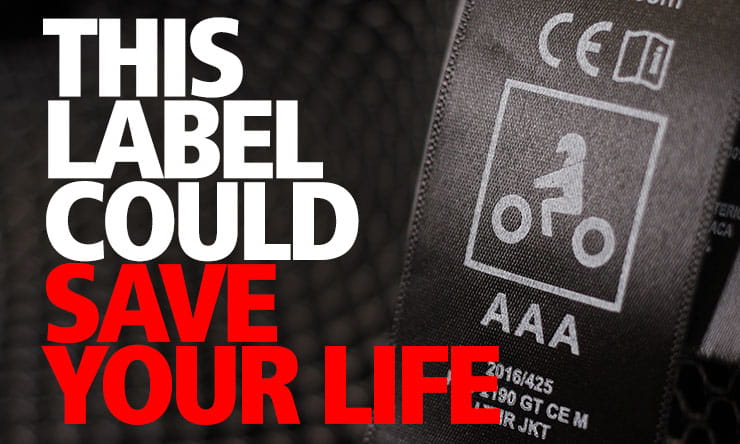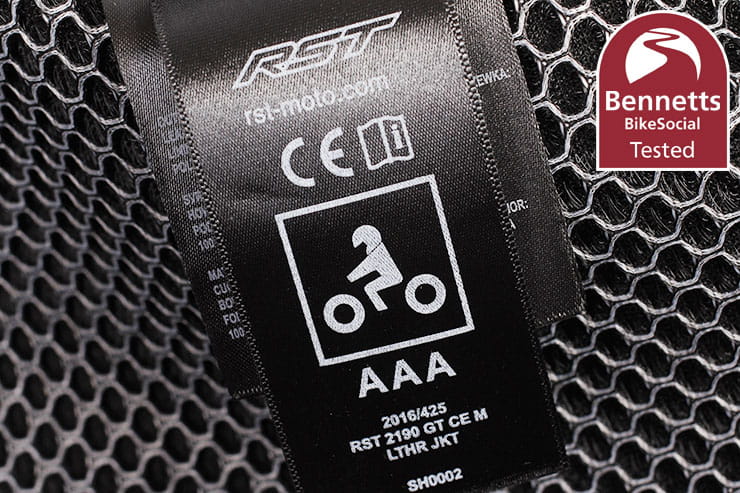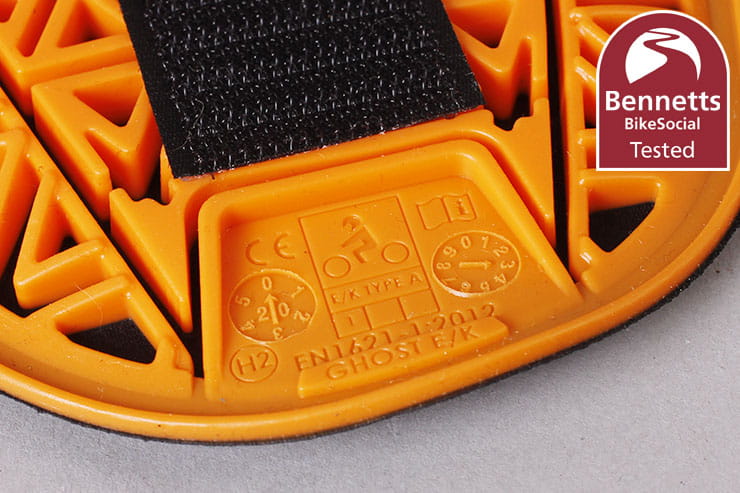
Every piece of motorcycle clothing you buy in the UK should now have a rating on it that gives you some idea of how protective it could be in a crash. But because so few riders are aware of the value of the information on this label, there aren’t many manufacturers taking the opportunity to shout about the results. On the other hand, some might also prefer you didn’t pay too much attention.
When you’re next shopping for bike kit, be sure to check out the safety ratings; it could make a big difference to where you spend your money.
While all new riding gear you buy should have the safety labels in that we explain below, there is a chance that you may still find some uncertified kit for sale due to an unofficial ‘amnesty’. If jackets, trousers, gloves or boots were brought onto the UK market (ie entered the retail chain in this country) before 21 April 2018, this old stock can be sold until it's cleared. For this reason, you might find some well-known brands available in discount clearances, for instance.
As a rough rule of thumb, if it’s a proper motorcycle clothing brand without labels – and it's not fake – there's a good chance that it could be old stock. If it’s a brand you've never heard of though, with no UK distributor, it might have been imported direct and had no testing carried out.
Either way, if it's not labelled, there are no guarantees of the product's protective qualities, so it's up to you to make the buying decision that you feel comfortable with.
Here’s everything you need to know about motorcycle clothing safety ratings in as easy-to-understand form as I could make it…
This article will be kept updated with any changes to any of the standards.
Finding the most provably protective riding kit is now even easier! Check out the Bennetts High Performance Award here.

Find the most protective kit with the Bennetts High Performance Award
This article explains all the standards you need to understand when buying protective motorcycle clothing, but if you want to keep things more simple, just look for the Bennetts High Performance Award on the next gloves, boots, jackets, trousers, jeans and one- and two-piece leathers you buy.
By highlighting only the riding kit that reaches the highest levels of protection, you can concentrate on choosing what you find most comfortable, has the features you want, and that’s in your price range.
Check out the safest motorcycle clothing at www.bennetts.co.uk/high-performance
Quick links to the key points
What’s the safest motorcycle helmet?
What’s the safest motorcycle jacket, trousers or leathers?
What’s the safest motorcycle body armour?
What are the safest motorcycle gloves?
What are the safest motorcycle boots?
What do I HAVE to wear when riding a motorcycle?
Is VAT charged on motorcycle riding kit?
How does Brexit affect this?

This lid meets ECE 22.05, which means it’s legal in the UK. Snell relates to an American standard that isn’t accepted in the UK. There’s also an ACU sticker on here, which means it can be used in racing and on track days
What’s the safest motorcycle helmet?
What label should I look for? All helmets sold in the UK must meet ECE 22.05 – or the newer and more stringent ECE 22.06 – and you’ll typically find it mentioned on the back of the lid, though there’ll also be a label on the strap.
What’s the safest helmet? ECE 22.05 and ECE 22.06 set out a minimum standard that ALL helmets sold in the UK (and Europe) must meet to be legally sold. You might also find an ACU sticker on the outside, though there is no additional testing carried for a helmet to receive this.
A good way to find more detail on the potential safety of a helmet is to visit the SHARP website, which gives star ratings for many of the most popular lids on the market, though at the time of writing this has barely any new helmets on, and is missing some of the most popular models of the last five years or more.
The ‘P’ on the strap here denotes it’s a full-face helmet. A ‘J’ would be for an open-face, while P/J denotes a flip-front that can be ridden in while open or closed
Anything else I need to know? The first ECE 22.06 helmets started appearing in 2021, though it’s not until January 2024 that ALL helmets manufactured will have to comply with ECE 22.06, which includes – among other changes – a ‘glancing-blow’ test, which examines the potentially life-threatening rotation of the brain during an impact. You will likely still find older stock 22.05 helmets available.
DOT-certified helmets are ILLEGAL to sell and ILLEGAL TO WEAR in the UK, unless they are also certified to ECE 22.05 or ECE 22.06, which must also be included on the helmet.
You can still wear a helmet certified to BS 66.58:1985, though these will all be very old by now. You can find what motorcycle helmets are legally required in the UK here, though at the time of writing it hadn’t been updated to include UNECE 22.06.

This leather jacket has been rated AAA under EN 17092
What’s the safest motorcycle jacket, trousers or leathers?
What label should I look for? All new motorcycle clothing should carry a label with the above pictogram, showing that it’s been certified to EN 17092. You might see it as prEN 17092, or even FprEN 17092, but that’s fine. If you want to know the full background to this new CE standard, click here.
What’s the safest jacket or trousers? EN 17092 is divided into four classifications that as a motorcyclist you need to know about: B, A, AA and AAA.
- B: This is deemed suitable for urban riding but without impact protectors
- A: Also for urban riding but including impact protectors
- AA: More suited to touring gear
- AAA: The highest level of protection specified by the standard
You might also still find some kit tested to EN 13595, though this is to Level 1 and the higher Level 2.
While it’s currently focussing mostly on products that feature in the Australian motorcycle market, the MotoCAP website is thoroughly recommended and does include products available globally, including in the UK. Like a garment-version of SHARP testing, this puts bike kit through a more rigorous set of tests and is well worth referring to before spending your money.
Finding the most provably protective riding kit is now even easier! Check out the Bennetts High Performance Award here.

This is NOT a CE-approved garment, despite having the pictogram. Compare it to the label in the pic above
Anything else I need to know? Before EN 17092 we had EN 13595, which was a much tougher test to beat (too tough for most textile gear). But once all motorcycle kit was deemed PPE (personal protective equipment) in April 2018, there needed to be a testing standard that bike kit was more capable of passing: enter EN 17092.
A lot of textile clothing is A rated, but know that plain jeans could often have the abrasion resistance to pass this, so if you have two garments that you’re trying to choose between, I’d go for the higher-rated one.
When it comes to leather kit, I’d really expect to see a AAA rating. Certainly, on leathers intended for track use or fast road, I would strongly recommend that you only go for AAA-rated kit.
Due to the way areas of risk are ‘zoned’ in testing, a garment might contain material that could pass AAA, but could still be rated A or AA – the entire test rating is what you’re looking for as it takes into account the seam strength, likelihood of impact in certain areas and other key points like how likely the arms are to pull up and expose flesh in a slide. Don’t let a brand try to fool you with claims of ‘material that passes AAA’.
It’s also worth knowing that CE-approval includes ‘innocuousness testing’, which looks for chemicals that could be seriously harmful to your health, and that any protectors fitted must be approved to the standards shown below…
What is EN17092 testing?
While some brands and sellers will try to downplay the value of EN17092 testing, it's actually a very useful tool for us all to compare the protection offered by motorcycle clothing. EN17092 testing is a set of minimum requirements covering:
- Abrasion resistance of ALL layers of the construction, only excluding the armour
- Impact energy absorption
- Seam strength and structural closures
- Tear strength
- Sleeve restraint (in jackets and one/two-piece suits)
- Fit and ergonomics
- Dimensional stability after washing
Clearly, EN17092 is far more than an 'elaborate abrasion test' as some would have you believe. The garment isn't abrasion tested in EN17092 with the armour fitted because the energy absorption is assessed separately using the EN1621 standard. EN17092 ensures the armour is compliant to Level 1 or Level 2, and that it's in the correct places. Good abrasion resistance under EN17092 also helps ensure the the outer layers remain whole and that the armour doesn't tear out and disappear down the road in a crash.
Ignore anybody who tries to tell you that the MATERIAL used in its product is 'AAA' or similar – EN17092 ONLY applies to the entire garment, not just the material used as the seam strength, zip security, tear resistance, fit and more all have to come together to produce a product that has a PROVABLE level of protection.
Finding the most provably protective riding kit is now even easier! Check out the Bennetts High Performance Award here.

This is a D3O back protector that offers full coverage (FB) and is certified to the latest standard at Level 2
What’s the safest motorcycle body armour?
What label should I look for? Impact protectors (the armour in your riding kit) must be tested to EN 1621 – look for the pictogram above stamped into them, though the text beneath will vary as below.
What is the safest armour? The various impact protectors have different test standards, so you’ll see these:
- EN 1621-1:2012 for shoulder (S), elbow (E), hip (H), knee (K) and lower leg (L) protectors
- EN 1621-2:2014 for back protectors: full back including shoulder blades (FB); centre back only (CB) and lower back only (LB)
- EN 1621-3:2018 for chest protectors (one piece or divided)
- EN 1621-4:2013 for mechanically-activated air vests
- EN 1621-5 for electronically-activated airbags (this standard is in development)
These protectors will be rated to Level 1 or Level 2, 2 being the higher and thus reducing the transmission of force to the body even further.
You may find T+ and T-, which indicate that the protectors have been tested at +40°C and -10°C respectively.
Other letters present will relate to the intended use (see the letters in brackets above), while for EN 1621-1 limb protectors ‘Type A’ means it’s the smallest size of armour and ‘Type B’ means it’s the largest. Back and chest protector sizes are based on the wearer’s waist-to-shoulder length.

This is a D3O elbow or knee protector (E/K) that is the smaller size (Type A) and meets Level 1
Anything else I need to know? Be very wary of companies confusing a garment that is CE approved (to EN 17092 or 13595), and a garment that only has CE-approved protectors fitted. The law surrounding motorcycle protective equipment has been in place long enough that you shouldn’t see this with legitimate brands.
All protectors MUST be CE-approved, but to be fitted to current clothing they should also meet the latest standards, so don’t accept armour that isn’t certified to the dates shown above. Foam should never be found in armour pockets.
When it comes to airbags, be very careful to check that the certification matches the numbers shown above as some sellers – who clearly have no interest in our safety – are selling ‘motorcycle airbags’ with declarations of conformity to BS EN ISO 12402-4:2006. This is the standard for personal flotation devices, NOT for impact protection. They also don’t need to inflate anywhere near as quickly to meet this standard.

This pair of gloves are approved to Level 1 and include knuckle protectors (KP)
What are the safest motorcycle gloves?
What label should I look for? Motorcycle gloves should be tested to EN 13594:2015 – look for the pictogram label above.
What are the safest gloves? Gloves will have a number 1 or a number 2 beneath the pictogram. Level 2 is the higher performance class. Testing at both levels involves assessments for the gloves’ ability to resist being pulled off in a crash, tear strength, seam strength, cut resistance, impact abrasion resistance (at palm) and knuckle impact protection (optional for level 1; mandatory for level 2).
The MotoCAP website also puts bike gloves through a more rigorous set of tests and is an ever-growing and hugely valuable resource.
Anything else I need to know? The cuff length is also rated level 1 or 2, so if it’s a short cuff, regardless of the results of the other tests, it’ll always be a rating of 1.
In level 1 gloves, the ‘KP’ symbol means knuckle protectors, which are optional, have been tested. In level 2 gloves, protectors must be fitted and they have to absorb more energy than specified for level 1, so if they’re fitted, you should see this under the pictogram of a rider.
It’s very important to see the pictogram and the exact wording above as some gloves have been known to use the CE certification for dye-fastness in gardening gloves!
Finding the most provably protective riding kit is now even easier! Check out the Bennetts High Performance Award here.

These boots have been tested to Level 2 for boot height, impact abrasion resistance, impact cut resistance and transverse rigidity
What are the safest motorcycle boots?
What label should I look for? Motorcycle footwear should be tested to EN 13634:2017 – look for the pictogram label above.
What are the safest boots? Under the pictogram and standards text, you should find four digits; either a 1 or a 2. Level 2 is the higher rating for the following (in this order):
- Boot height (ankle boots are 1, taller boots are 2)
- Impact abrasion resistance
- Impact cut resistance
- Transverse rigidity (the resistance to crushing if trapped under a bike)
Finding the most provably protective riding kit is now even easier! Check out the Bennetts High Performance Award here.

These boots have also been tested for water resistance, slip resistance on a steel floor with glycerol and water absorption / desorption of the lining materials
Anything else I need to know? You might also find several acronyms, which are for optional tests:
- IPA: Impact protection at the ankles
- IPS: Impact protection at the shins
- WR: Tested for water resistance
- FO: Resistance to degradation of the sole through contact with fuel
- SRA: Slip resistance tested on ceramic tile wetted with dilute soap solution
- SRB: Slip resistance tested on smooth steel with glycerol
- SRC: Slip resistance tested on both of the above
- WAD: Water absorption and desorption of the lining materials
- B: Water vapour permeability of the uppers
While there’s a lot to think about, those four digits being either 1 or 2 will really help you compare the protection that different boots can offer.
As with gloves, make sure you look for the pictogram of a motorcycle rider to be sure you’re buying kit designed for motorcycle use.
What do I HAVE to wear when riding a motorcycle?
By law, the only thing you MUST wear when riding a motorcycle or scooter is a helmet. You could be naked otherwise, but please don’t.
There is no legal requirement to wear personal protective equipment (beyond the helmet), but as all new kit is PPE, and as the last two years have proven that retail prices haven’t really been affected by the testing that manufacturers must carry out, there’s no obvious reason not to.
You can ride in shorts and a tee-shirt if you want to, but I’d strongly recommend that you don’t. Also, if you were in an accident involving a third party, any injury claim could be reduced by that third party’s insurer due to ‘contributory negligence’.
Is VAT charged on motorcycle riding kit?
Motorcycle helmets aren’t chargeable for VAT, but they are a legal PPE requirement. There’s no legal requirement to wear any of the other protective equipment, so HMRC has no reason to not take that cut.

How does Brexit affect this?
Products sold in the UK must be UKCA certified from 1st January 2022, and must include the UKCA mark on any labelling from 1st January 2023 (you might see it on some kit already), but this will be in addition to the CE mark, and the standards are the same.
Any products sold ONLY in the UK could carry just the UKCA mark, but it’s unlikely you’ll find any of these in motorcycling apparel.

Bennetts direct insurance customers get membership for FREE, or you can become a member for just £6 / month and start getting rewarded today.
- Discounted track days and rider training at some of the top UK circuits
- Exclusive savings and discounts on everything you need from the world of motorcycling
- Unique experiences and VIP access at the very best motorcycling events
- Exclusive competitions and prizes all year round




















